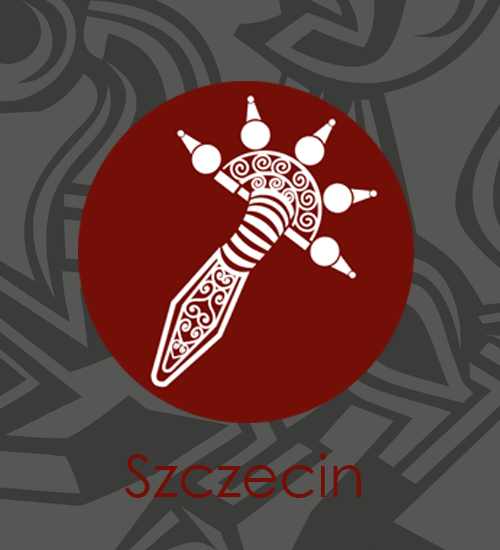Barbarian tsunami
Migration Period between the Odra and the Vistula
The online version of the exhibition
Full many a wonder is told us in stories old,
of heroes worthy of praise, of hardships dire,
of joy and feasting, of weeping and of wailing;
of the fighting of bold warriors, now ye may hear wonders told.
(The Nibelungenlied, translated by Daniel B. Shumway, New York 1909)
Exhibition Barbarian Tsunami is dedicated to dramatic events in the history of Europe which disturbed the civilization of Late Antiquity between the end of the 4th and the early 6th century, the time known as the Migration Period. Those were the days of intense migration of Barbarian tribes which invaded the Roman Empire with territories throughout Europe and North Africa and struck the final blow to the Western Roman Empire. They often established their own kingdoms over its ruins. Some of these tribes, recorded in Late Antique written sources, originated from the Odra and the Vistula river basin region which they inhabited in the first centuries AD. They played a crucial role in the events of the Migration Period creating the new order in medieval Europe. Evidence of their presence on the territory of Poland as well as contacts with other Barbarian communities and the Roman civilization is discovered in different regions between the Baltic Sea and the Carpathian Mountains. These are very often some of the most spectacular archaeological finds from the territory of Poland which are later of great value in museum collections of archaeological objects.
A selection of the most important objects from the Odra and the Vistula river basin region, supplemented with a few finds from the Black Sea region and the territory of today’s France, was displayed at the joint exhibition which is based on collections compiled by Polish museums. Most of the objects come from hoards and richly furnished graves. They illustrate the presence of various communities on the territory of Poland as well as their role in cultural exchange and transformations of the Migration Period against a background of events that happened before this period (the 3rd and the 4th century) and afterwards (the 6th and 7th century).
The exhibition was organised by the National Museum in Szczecin and the University of Warsaw in cooperation with eleven museums. It is also the outcome of the National Science Centre-funded Maestro project “The Migration Period between the Odra and the Vistula" which was run in the recent years at the University of Warsaw by a group of Polish researches in collaboration with fellow researchers from other European countries.
The exhibition was presented in twelve museums in Poland starting from the end of October 2017 to March 2020. It combines traditional display, where the objects play a crucial role, with modern technologies which, in a dynamic yet discreet way, allow to expand information about the period, the items, and the results of natural sciences research supporting the reconstruction of the past settlement.
“… of the fighting of bold warriors, now ye may hear wonders told!” – the introductory quotation from the medieval epic poem The Nibelungenlied is not only to encourage to view the exhibition in the online version, but also to emphasise that the Odra and the Vistula river basin region was a scenery for significant transformations in Late Antiquity. Here, in the Middle Odra basin, the Burgundians resided before the migration – the epic poem is set in their environment, whereas its historical background is based on the events from the Migration Period.

The travelling exhibition
Muzeum Narodowe w Szczecinie: 10.2017–01.2018
Państwowe Muzeum Archeologiczne w Warszawie: 01.2018–03.2018
Muzeum Lubelskie w Lublinie: 03.2018–05.2018
Muzeum Warmii i Mazur w Olsztynie: 06.2018–08.2018
Muzeum w Lęborku: 08.2018–10.2018
Muzeum Archeologiczne w Poznaniu: 10.2018–01.2019
Muzeum Zamojskie w Zamościu: 01.2019–03.2019
Muzeum Regionalne im. Janusza Petera w Tomaszowie Lubelskim: 03.2019–05.2019
Muzeum Okręgowe w Rzeszowie: 05.2019–08.2019
Muzeum Archeologiczne w Krakowie: 08.2019–10.2019
Muzeum Miejskie Wrocławia: 10.2019–01.2020
Muzeum Okręgowe Ziemi Kaliskiej w Kaliszu: 01.2020–03.2020
Concept of the exhibition: Aleksander Bursche, Krzysztof Kowalski, Magdalena Mączyńska
Art design: Karolina Gołębiowska
Multimedia: Michał Dłużak, Krzysztof Dzierma, Paweł Pawlicki, Maciej Szelachowski, Małgorzata Latałowa
Arrangement: Izabela Sukiennicka, Anna Ryś
Translation: Anna Kinecka, Monika Witek
















